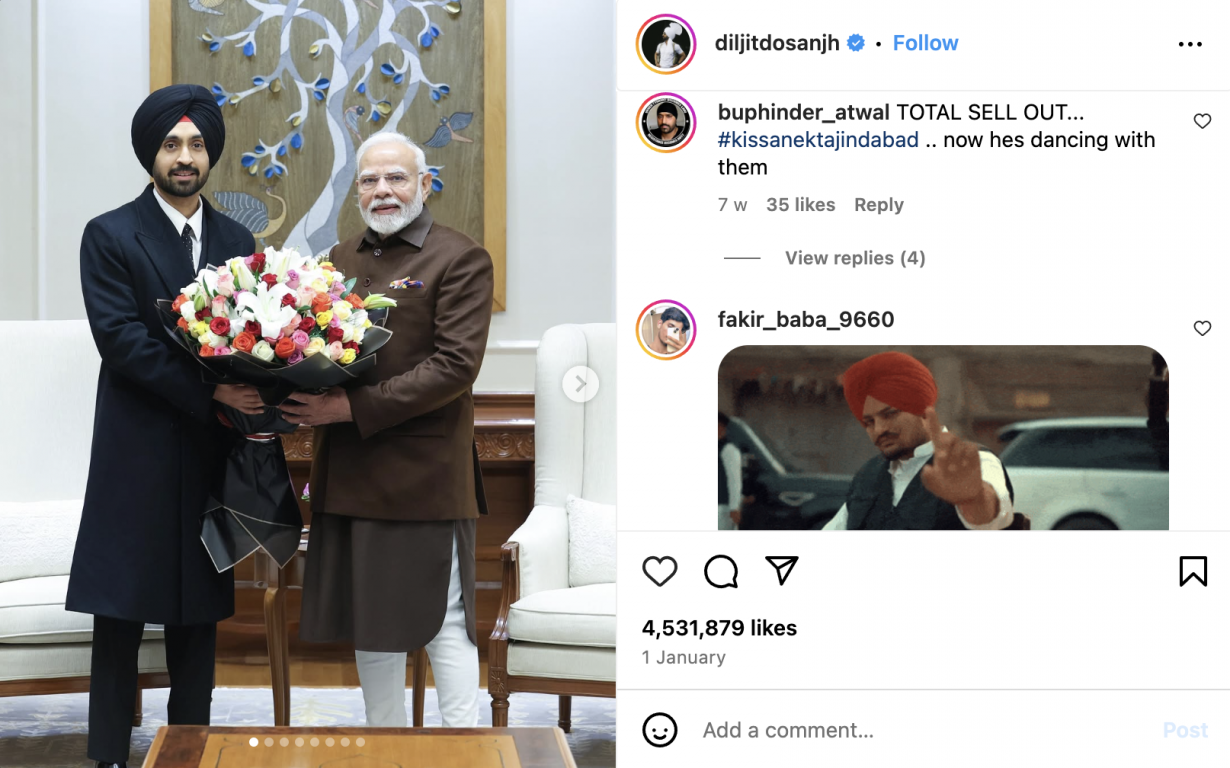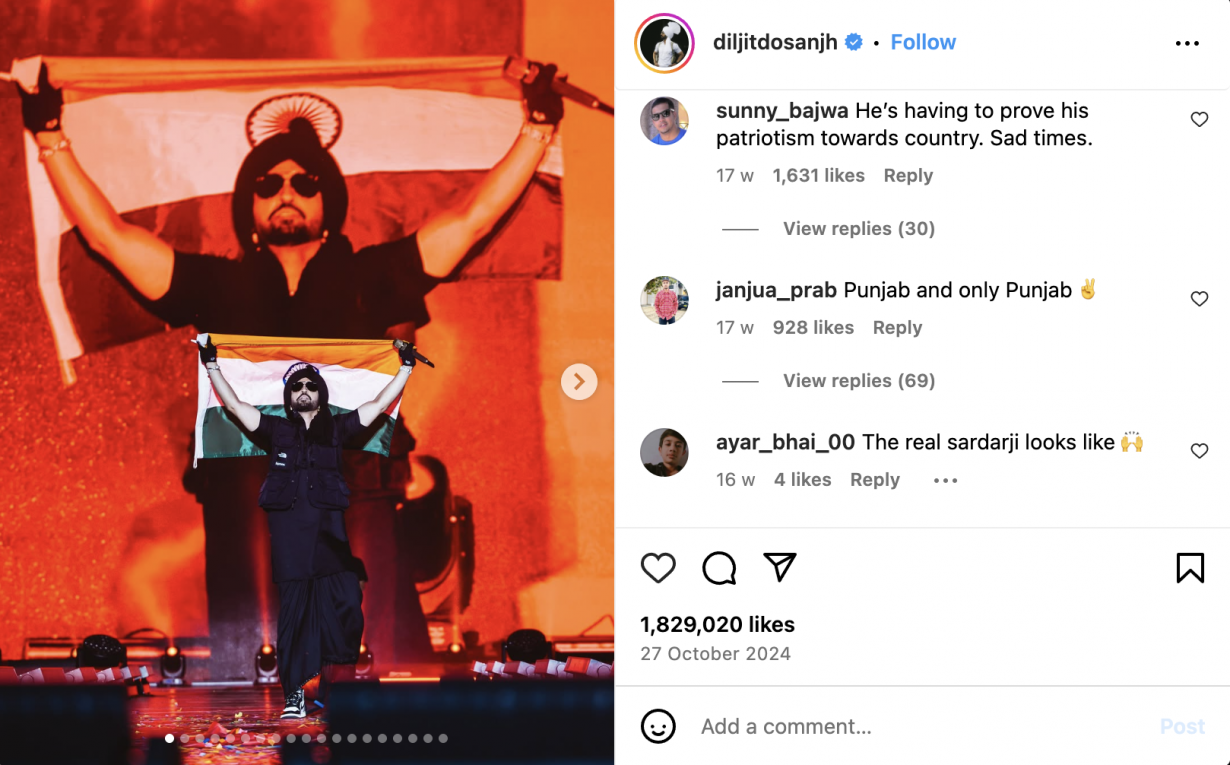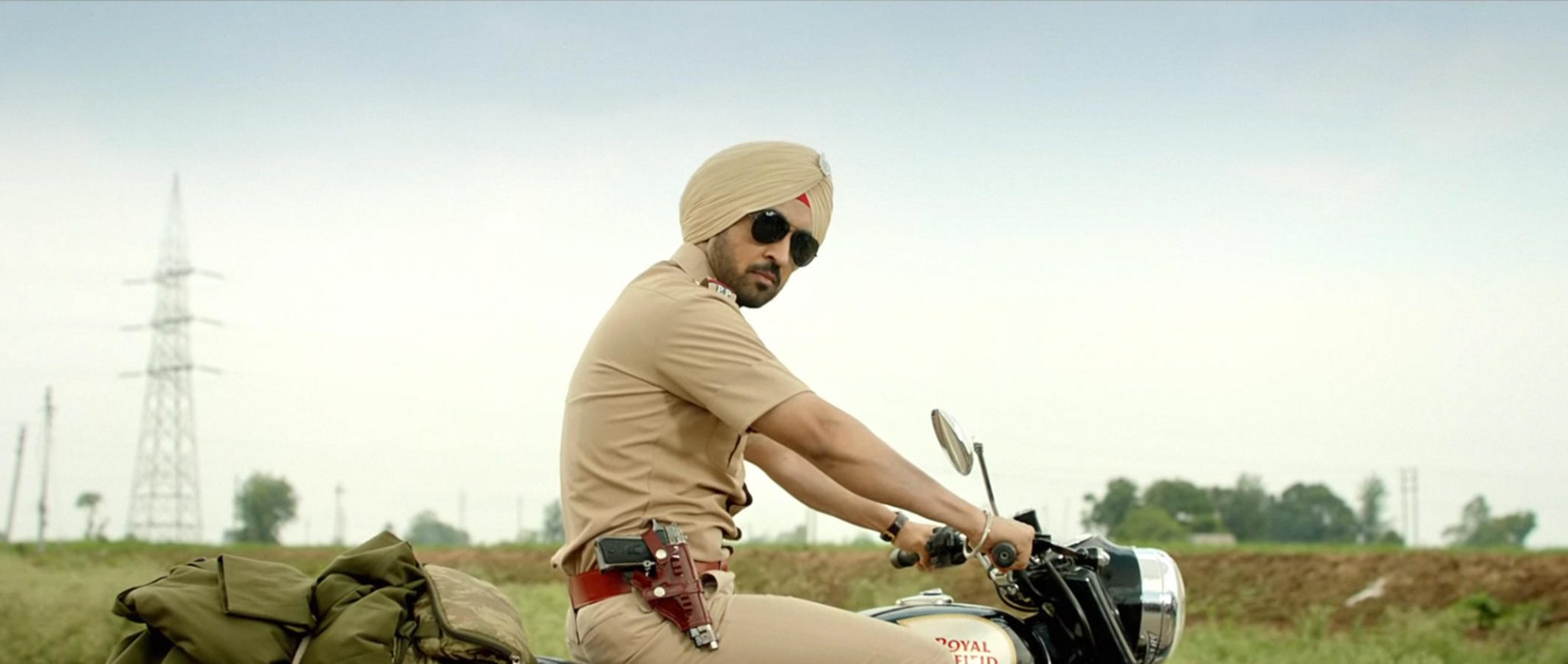Will the Panjabi singer still be able to say anything meaningful about where he comes from, now that he’s a global superstar?
Celebrity and pop culture is often nothing to do with a specific individual and everything to do with a certain phase in a country’s cultural history. This is perhaps most obviously evident in the meteoric rise of Panjabi singer, actor, producer and now global superstar Diljit Dosanjh. His recently concluded Dil-Luminati world tour, and the many controversies and criticism around it that filled the entertainment pages for much of 2024, offers a study of celebrityhood in divisive times.
Since his appearance at the Coachella Valley Music and Arts Festival in April 2023, where his declaration “Panjabi Aa Gaye Coachella Oye” (The Panjabis have arrived at Coachella) made him a viral sensation in India, followed by a string of high-profile media appearances including The Tonight Show Starring Jimmy Fallon, and collaborations with Ed Sheeran, Camilo, Sia and others, Dosanjh’s rise to superstardom has invited much scrutiny.
During the India leg of Dil-Luminati, nearly every show was bookended by protests and incessant trolling by Hindutva fundamentalist groups. The most serious charge against him was that he was a supporter of Khalistan (a movement demanding a separate state for the Sikh community) and therefore anti-national. Dosanjh had donated money to and expressed support for the farmers protesting against three farm acts in 2020; pro-government media had relentlessly branded the farmers Khalistan supporters and anti-nationalists. Dosanjh’s best answer to his detractors came during his concert in the national capital, New Delhi, when he walked on stage with the country’s tricolour flag wrapped around his shoulders, declared his love and respect for all Indian languages and proceeded to sing Main Hoon Panjab (I am Panjab), each move reading like a political statement against the right wing’s agenda to dismiss the complexities of patriotism and regionalism and reduce them to their basest meaning – jingoism and separatism.

Yet, his tone-deaf comments on Kashmir during the Mumbai leg of the tour, just after his visit to Jammu & Kashmir – stating the region was fully under the control of the Indian Army, thereby insinuating that it was safe to visit – led to severe backlash from those who view India’s militarisation of the troubled state as an act of imperialism by an occupying power. That tickets to his concerts cost between Rs5000 and Rs60,000 (£45 – £550, approximately) during a cost-of-living crisis and an ailing economy drew much flak, even though they sold out within minutes. And then Dosanjh rang in the new year with a meeting with Prime Minister Narendra Modi, a photo op that seemed to confuse people across the political spectrum.
To understand the balance that Dosanjh is attempting in his public appearances, one must look at the sociopolitical history of Panjabi music, indeed of the state itself. Panjabi music has been popular in clubs and at wedding parties across northern India for several decades, its fast-paced, foot-thumping beats fitting well with the pop culture mythology of the fun- and drink-loving Panjabi people. Although Panjabi folk songs and poetry have been incorporated into Hindi films for most of the twentieth century, it wasn’t until the 1990s Indie-pop boom that elements of Panjabi music became a staple in Hindi films, where it is often used for dance numbers or ‘item songs’, and gained popularity across the country. A lot of the lyrics written by the likes of Dosanjh celebrate the caste pride of the landowning Jutts, and evoke a supposed ideal past that, in reality, was feudal, patriarchal and violently casteist. For the diaspora, which forms a substantial market for this music, it fortifies their rose-tinted nostalgia for the simple rural village life back home. At the same time, the Panjabi hip-hop and gangster rap that has been trending for a while now depicts an aspirational lifestyle filled with expensive fast cars, submissive women and much wealth. Both these stereotypes of the region help keep these songs in regular circulation among the youth.
The northwestern state of Panjab has been ravaged in the last eight decades, first by Partition, when the state was distributed between India and Pakistan, then by religious militancy fuelled by the Khalistani movement, and now by the pressures of the Green Revolution in agriculture and its severe impact on both land use and economic and social relationships. With high rates of unemployment, class/caste divide, rampant drug abuse and migration (several of the illegal immigrants deported by the Trump government recently were from the state) adding to the toxic mix, these songs fill a void left by institutional politics that have failed to bring about any measure of positive change. Several musicians in Panjab have been assassinated for their political opinions, getting caught between gang warfare, as was the case with Sidhu Moose Wala, a popular rapper who was killed in 2022.
Dosanjh is prolific. Since the release of his first album, in 2003, he has gone on to make over a dozen studio albums and 40-something singles, acted in more than 30 Punjabi and Hindi films, toured extensively and been in multiple brand collaborations. He has also starred as the Dalit artist Amar Singh Chamkila (in a 2024 film by the same name), one of the most popular singers during the 1980s, who was allegedly assassinated by Sikh militants.

Arguably, while there may be artists better at their craft than Dosanjh, he can be credited for making Panjabi language and culture globally cool. Sporting turbans and traditional attire, while also in jackets and fancy shoes, and speaking mostly in Panjabi, his English heavily accented, he seems to epitomise a star who is at ease being both traditional and modern, standing for universal love and tolerance, rooted, yet unapologetic about showing off his private jet and immense wealth. For many fans who see him as one of the biggest voices of dissent against majoritarianism and anti-farmer policies, his meeting with Modi is dismissible as a means to an end; the global validation of Panjabi-ness that he seems to facilitate is more important. If one can rely on the hundreds of comments on his social media posts or sift through threads on Reddit, it seems like the applauders outnumber those who critique his actions, even though there are several ‘sellout’ and ‘unfollowing’ comments below his pictures. That music too is a business, inseparable from capitalism and therefore empty of conscience, comes up often, and that he is also a businessman having to look after his interests seems acceptable to fans who would rather debate how religious, or not, he is.
When Hindutva protests threatened to cancel Dosanjh’s show in Indore, he quoted from a poem by the city’s Urdu poet Rahat Indori, ‘Kisi Ke Baap Ka Hindustan Thodi Hai’ (Hindustan/India is no one’s father’s property), reminding his detractors of India’s diversity and syncretic values. His later statements on Kashmir, though, alongside a starring role in the forthcoming Border 2 – a sequel to a war movie that, going by Bollywood’s current love affair with hypernationalistic films, will likely be a high-octane glorification of violence and jingoism – seem like a volte-face. But businesspeople-artists have long since bent backward to appease the Hindutva right and its poster-boy prime minister. Those opposing majoritarianism are so desperate for a popular hero that when, instead, such artists fall short of our very high expectations to emerge as astute businesspeople, the damnation is quick and just as vicious as the Hindutva right’s response to a celeb’s public displays of liberalism. Dosanjh, like other big names in the entertainment industry, might challenge what pro-government groups these days find permissible from public figures, quoting from some progressive poetry here, donating money to a populist movement there, but only just enough to cover the spectrum of his fan base, and certainly not enough to count as speaking any sort of truth to power. We should know by now that celebrities (not art and artists as a whole, it must be noted) are among the weakest links in the chain of dissent. To expect that Dosanjh, or those like him, will ever publicly stand firm is just confusing the forest for the trees.
Deepa Bhasthi is a writer based in Kodagu
From the Spring 2025 issue of ArtReview Asia – get your copy.
